This post contains affiliate links.
Discover whether hummingbirds mate for life and explore the unique mating habits of these mesmerizing birds. From courtship displays to nest building, learn how hummingbirds find and woo their partners in the wild.
Amidst the flutter of iridescent feathers and the mesmerizing dance of flight, hummingbirds lead a fascinating existence that captivates enthusiasts around the globe. One question that often arises within the community is whether these avian jewels maintain lifelong relationships. “Do Hummingbirds Mate for Life?
Understanding hummingbird mating habits delves into the intimate world of hummingbird reproduction, exploring the myths and realities of their pairing rituals to unravel the mysteries of their amorous conduct. Prepare to be enlightened on the nuances of fidelity and breeding behavior in the life of hummingbirds.
Do Hummingbirds Mate for Life? Unveiling the Mating Habits of Hummingbirds
In the enchanting world of hummingbirds, one question that is often asked: do hummingbirds mate for life? The breeding behavior of hummingbirds reveals a fascinating pattern; unlike some avian species that form monogamous pairs, hummingbirds do not mate for life. In fact, the concept of lifelong partnership is foreign to them.
During the vibrant frenzy of the mating season, male hummingbirds engage in elaborate courtship displays to attract females, showcasing their vibrant plumage and aerial acrobatics.
Once the female selects a suitor, the two hummingbirds mate and this union is fleeting. Following this brief encounter, the male departs, leaving the female to single-handedly construct a nest, incubate her eggs, and care for the hatchlings.
Read my article: Hummingbird Parents: (Mating to Nesting)
This absence of long-term pair bonds highlights a significant difference in their mating habits compared to other birds that do mate for life. Instead, the focus is on genetic diversity and the proliferation of these avian wonders across diverse habitats.
Hummingbirds do not create lifelong relationships, however the intense, ephemeral connections they create each season are pivotal for the survival of their species. Understanding that hummingbirds do not mate for life allows enthusiasts to appreciate the independence and resilience of these feathered jewels.
While the phrase hummingbirds mate for life is a misconception, the reality of their mating practices is equally captivating, offering a glimpse into the complexity of nature’s grand tapestry.
Next time you observe these dynamic creatures, remember the mating bonds of hummingbirds underlines an extraordinary life strategy that enables the hummingbirds’ ethereal presence in our gardens and wild spaces year after year.
Life Cycle: Understanding How Hummingbirds Breed and Mate
The life cycle of the hummingbird is as mesmerizing as their vibrant plumage and dynamic flight patterns. A fascinating aspect of their biology is the timing of when hummingbirds mate.
Young hummingbirds begin mating and reproducing when they are one year old, a critical juncture in their life cycle.
Mating rituals of hummingbirds are elaborate affairs. Males showcase their aerial prowess and vibrant colors to woo potential partners. Once a pair has mated, which is a brief encounter usually lasting 3 seconds, the female hummingbird takes on the responsibility of constructing a hummingbird nest. Nimble and meticulous, she crafts this nest with natural materials, creating a snug haven for her hummingbird eggs.
The nesting period is a period of singular dedication, with the female hummingbird expending great energy to lay usually two eggs, which are akin to tiny jewels. The incubation period for hummingbird eggs is approximately two to three weeks.
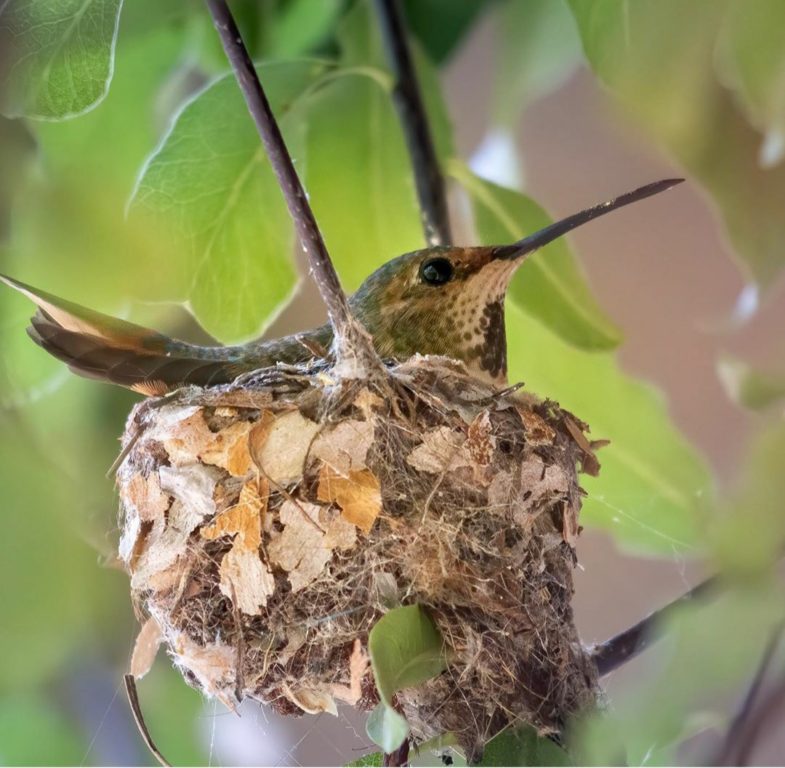
Photo by: Aaron Gomperts
During this time, the mother will leave the nest only briefly to feed. Baby hummingbirds emerge, blind and featherless, completely reliant on their mother for nourishment.
A hummingbird’s nest, therefore, is not merely a structure; it is the cradle of the next generation, a nurturing space for young hummingbirds to grow and mature until they are ready for their first flight.
Read my article: Baby Hummingbirds: (Egg to Fledgling)
As these fledglings leave the nest, they venture into a world where they will live, feed, and eventually breed, perpetuating the life cycle of their species. Contrary to common belief, hummingbirds do not breed for life, but their breeding behavior is critical in maintaining hummingbird populations.
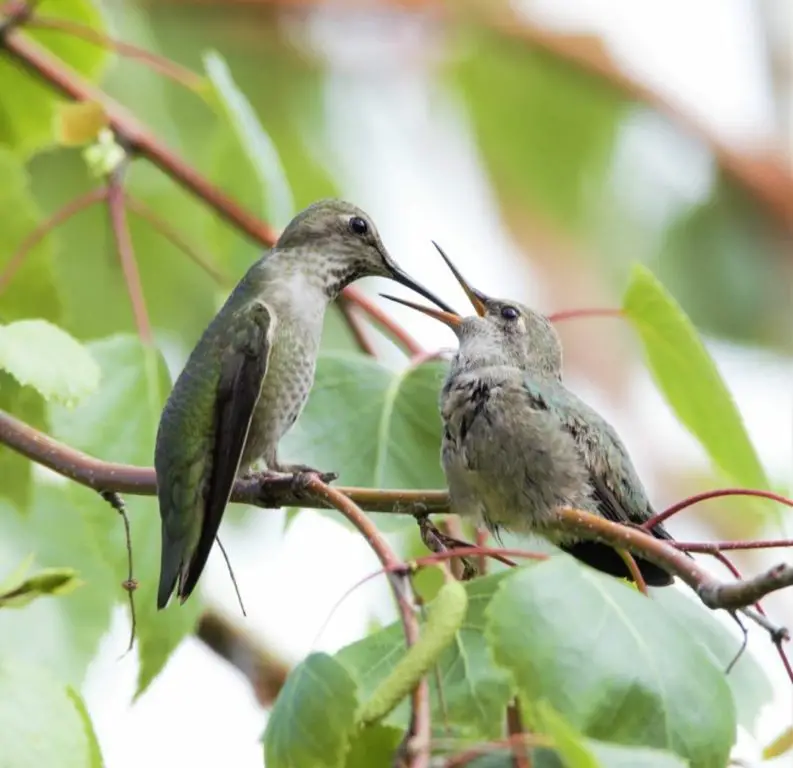
Photo by: Mehta.vishal.360
After the fledglings left their nest I witnessed the mother hummingbird locate her babies roughly 40-50 feet away in a nearby tree by following the high pitch chirps they produced to tell her of their location and that they were hungry and waiting for the next meal.
Whether they are hovering over nectar-rich blossoms or sipping from a feeder, their success in mating, the integrity of a hummingbird’s nest, and the subsequent care of baby hummingbirds are pivotal in the ongoing dance of life for these ethereal birds.
Male Hummingbirds: Flirting or Fighting During Mating Season?
When observing the vibrant spectacle of male hummingbirds during the mating season, one cannot help but be enthralled by their dynamic mating rituals. Contrary to some species that form lasting pair bonds, hummingbirds do not mate for life. They are in fact polygamous.
Each year, male hummingbirds showcase an array of impressive maneuvers designed to capture potential mates. These include intricate aerial displays, vivid flashes of their iridescent throat feathers (gorget), and a symphony of chirps and twitters. It is a form of flirting that is competitive and captivating.
Read my article: Hummingbird Dance: 5 Interpretive Explanations
However, do not mistake this courtship for a harmless display. The male hummingbirds engage in fierce aerial combat to assert dominance and secure the right to mate. It is during this period that the male’s prowess and vitality are put to the test. There is an undeniable fervor in these skirmishes—a dance of agility and speed—that underscores their will to propagate their lineage.
As a spectator to these grand performances, it is essential to understand that though the male hummingbirds are not monogamous, and they certainly do not mate for life, their mating behavior is singularly focused on ensuring their genetic contribution to future generations.
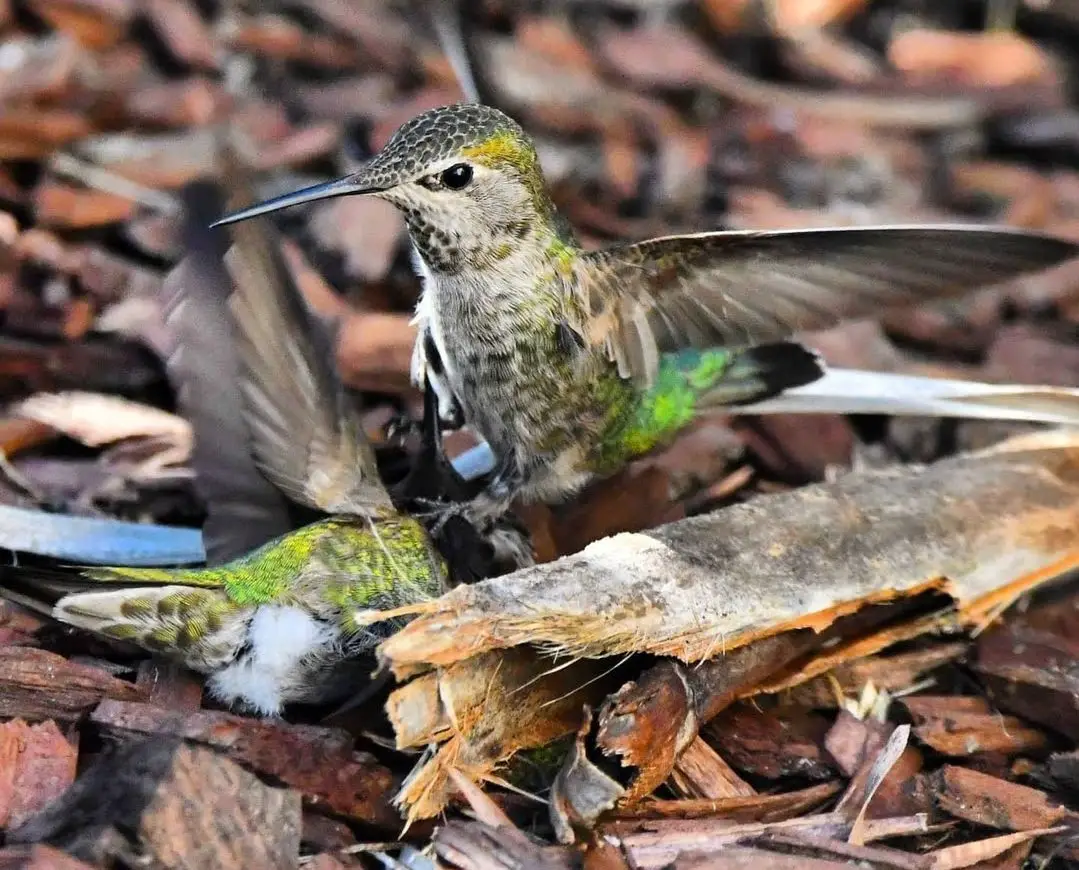
Photo by: mehta.vishal.360
The way male hummingbirds approach mating is more than just a seasonal fling; it is a fundamental aspect of their life cycle. To witness male hummingbirds in their prime, courting and occasionally clashing under the auspices of procreation, is to see nature’s relentless drive for survival. It is a genuinely breathtaking facet of hummingbird society.
Hummingbirds are driven by biological imperatives during mating season, and while they may not forge lifelong bonds, the male hummingbirds’ dedication to mating is a testament to nature’s inexorable rhythms.
The Return Journey: Do Hummingbirds Come Back to Breed at Their Birthplace?
One of the most fascinating aspects of hummingbird behavior is the return journey they undertake each breeding season.
Many hummingbird enthusiasts eagerly anticipate whether these iridescent birds will honor their birthplace with a poignant homecoming. The question of whether hummingbirds come back to breed at their birthplace is a topic of considerable interest within the ornithological community.
It is observed that many hummingbirds exhibit site fidelity, often returning to the same locale, and sometimes even to the exact same garden where they fledged to court and breed year after year. This regal return is not only a testament to their incredible navigation skills; it also hints at a purposeful thread in the fabric of their DNA.
Read my article: Hummingbird Migration: Familiar Journeys to Previous Locations
When discussing the breeding habits of hummingbirds, it is essential to understand that while they return to familiar territories, they do not mate for life. Mating is a solitary event for the hummingbird with males displaying flamboyant aerial displays to attract females.
Once the act of breeding is concluded, males have no further involvement with the female or the offspring. The return journey is thus not a rendezvous of lifelong partners but rather a pilgrimage back to a conducive breeding environment.
The male hummingbird’s territorial instincts are often misconceived as fighting during the mating season when indeed these displays serve as both courtship and a show of dominance over breeding territories.
See my article: Why Hummingbirds Chase Each Other: Is it Friend or Foe?
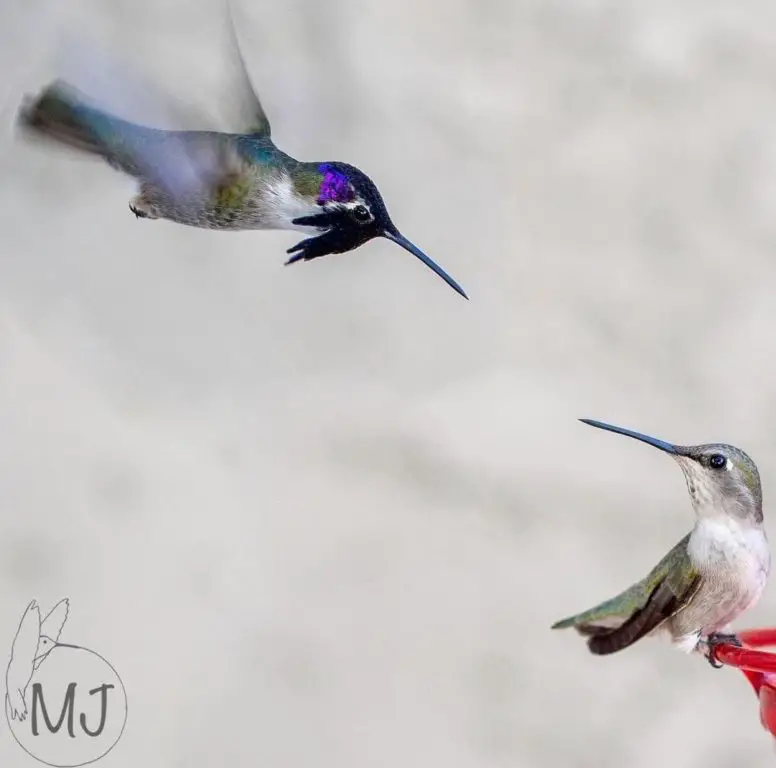
Photo by: hummingbirdsbysuprise
Therefore, the fidelity of hummingbirds to their birthplace and chosen breeding grounds underscores the importance of these areas for their life cycle. Though they do not breed for life, the repeated return of hummingbirds to breed in their natal places is a phenomenon that continues to captivate and intrigue those who closely follow these exceptional avian navigators.
Family Ties: Do Hummingbirds Stay Together After Mating?
When considering the intricate dance of the hummingbird’s mating practices, one might wonder about the strength of family ties within these vibrant communities. Contrary to what some might expect, hummingbirds do not forge the long-term bonds we often associate with monogamous species.
The question, “Do hummingbirds stay together after mating?” yields a surprising answer. The fleeting nature of their pairing reveals that within the hummingbird’s life cycle, each encounter between male and female is short-lived, and instead, the male and female go their own way after mating is complete. This absence of enduring ties means the male hummingbird does not mate for life.
Consider the nest, a structure meticulously crafted by the female hummingbird alone. It is she who must ensure the safety and comfort of her future offspring, for she is left to tend to the eggs and nurture the hatchlings without the assistance of her mate.
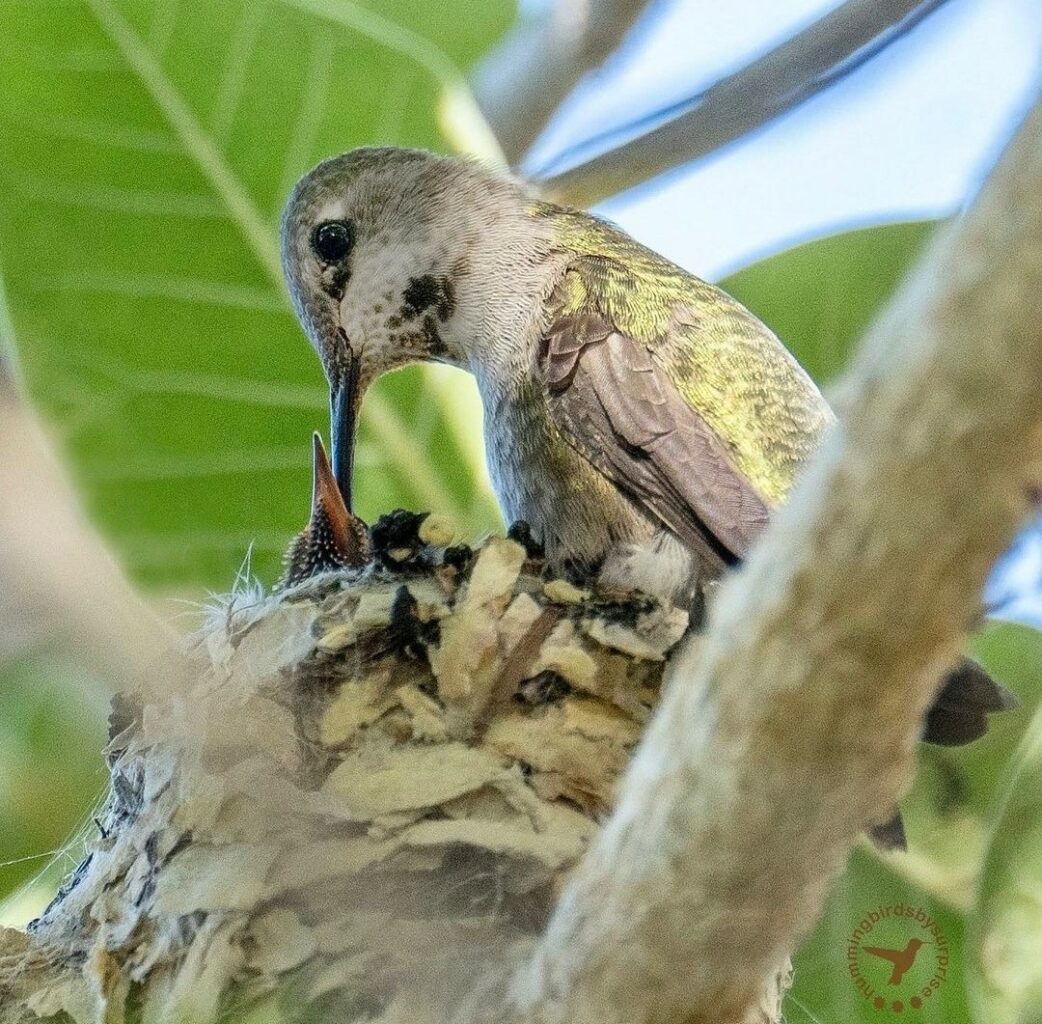
Photo by: hummingbirdsbysuprise
The male’s role in the family is singular and brief, his contribution ending almost as soon as it has begun. Consequently, when we observe hummingbirds in their natural habitats, these birds appear to be the epitome of independence, driven by instinct rather than by long-term familial connections.
The hummingbird’s mating habits provide an intriguing snapshot into the diversity of avian reproduction strategies, where each species does what best ensures their survival and the continuation of their lineage.
Through our exploration of their mating personalities, ranging from the male hummingbirds’ vibrant courtship displays to their protective ferocity during the mating season, the male hummingbird does not participate in the nurturing of offspring. Nest-building, feeding, and raising the young fall solely under the female’s domain.
The cycle continues, raising the question of whether hummingbirds demonstrate loyalty to their birthplaces. Do hummingbirds come back to breed at their birthplace? While they do not maintain family ties, hummingbirds are known for their incredible homing instincts, often returning to the very spot they were hatched to start their own families.
Thus, while the ties that bind hummingbird families are not maintained by lifelong mates, the threads of connection are woven into the fabric of their migratory and reproductive patterns.
Check out my other posts on Hummingbird Questions
Frequently Asked Questions
Q: Do hummingbirds mate for life?
A: Hummingbirds do not mate for life. They have brief mating encounters, after which the male moves on, and the female is left to build the nest and raise the young on her own.
Q: When do hummingbirds begin mating and reproducing?
A: Hummingbirds start mating and reproducing when they are one year old. This marks an important stage in their life cycle as they reach sexual maturity.
Q: What are some characteristics of hummingbird mating rituals?
A: Male hummingbirds engage in elaborate and competitive courtship displays, of complex aerial maneuvers, singing and showcasing their brightly colored feathers. These displays are intended to attract females and assert dominance over other males.
Q: Do male hummingbirds take part in raising the young?
A: No, male hummingbirds do not participate in nest-building or caring for the hatchlings. Their role ends after mating, leaving the female hummingbird to handle the responsibilities of building the nest, incubation, and rearing the young alone.
Q: Do hummingbirds return to their birthplace to breed?
A: Many hummingbirds exhibit site fidelity, often returning to the same area, or even the same garden, to breed each year. While they do not retain the same mating partners, they do demonstrate a remarkable sense of navigation and loyalty to their natal locale.
Happy Hummingbird Watching!
Backyard Visitors participates in affiliate programs which compensate us for referring traffic.

